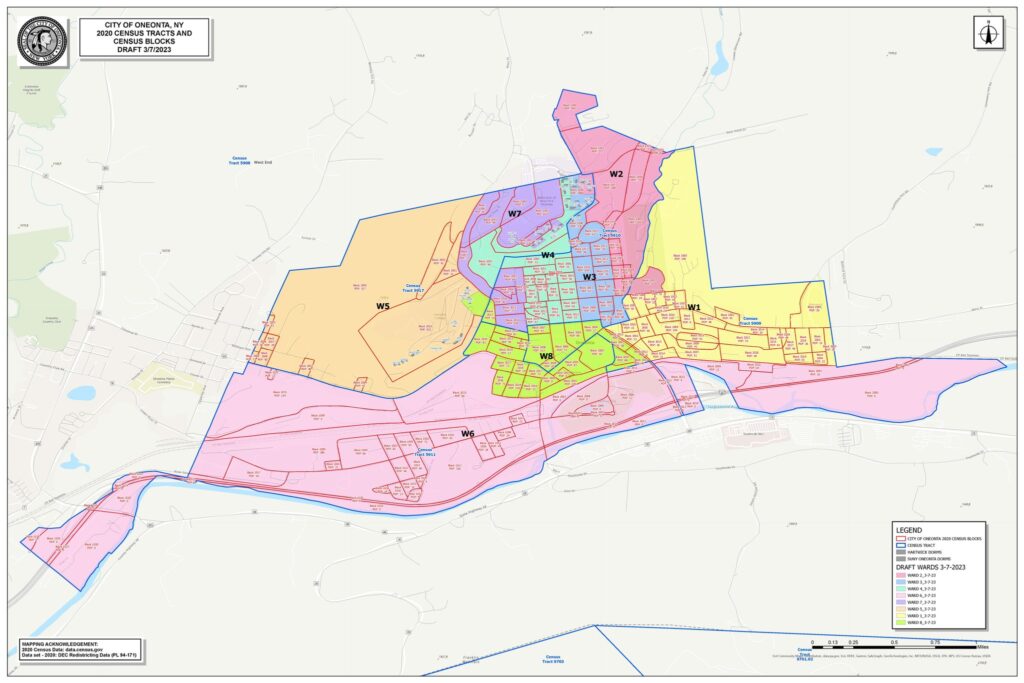
Commission Holds Hearing
Redistricting Explained; Draft District Map Viewed
By WRILEY NELSON
ONEONTA
The City of Oneonta 2020 Redistricting Commission held a public hearing on its proposed Common Council ward map on March 28. To ensure that each vote counts equally, New York’s Municipal Home Rule Law requires cities to reapportion their voting districts after the decennial federal census. The COVID-19 pandemic made this process considerably more difficult in Oneonta; SUNY Oneonta and Hartwick College students—who make up a significant percentage of the city population—were absent and often difficult to reach during the census. The census used dormitory population reports from April of 2020 to estimate the student population. Like other upstate localities, Oneonta has also experienced an influx of downstate residents affected by the pandemic. The Common Council appointed a redistricting commission on November 15, 2022.
Commission Chair Gary Herzig, city mayor from 2015 to 2021, opened the meeting with a discussion of the state and city laws guiding the commission’s work. The most challenging guideline, he said, was the population provision in MHR section 10: “the difference in population between the most and least populous district shall not exceed five percent of the mean population of all districts.”
In Oneonta, Herzig explained, “The most populous ward can have no more than 80-something people more than the least populous ward. That’s a high bar for us to meet.”
The state also forbids redistricting with any intent or result of abridging the electoral rights of minority communities. Wards must have contiguous territory and must be as compact as possible.
The commission spent much of its time considering communities of interest, which are identifiable groups with a unique common interest that may be affected by council action. Thanks to the efforts of committee members William Shue (Sixth Ward) and Glenn Pichardo (Seventh Ward), Oneonta’s Sixth Ward and college students were each identified as communities of interest. It was not possible to fit all SUNY Oneonta and Hartwick College students into a single ward. Herzig stated that the commission had done everything possible to ensure the Sixth Ward and the students could continue to act as communities.
During the public comment period, Hartwick College student Jasmin Ahmed expressed concern about a Hartwick freshman dorm placed in the Eighth Ward, separate from the rest of the college in the Fifth Ward. City Administrator Greg Mattice replied that it may not be possible to move the boundary without violating the population rule.
Herzig thanked Mattice and Engineering and Public Works GIS Specialist Maureen Seymour on behalf of the entire commission for their tireless work in creating the draft ward map. Their assistance saved Oneonta taxpayers a $16,000.00 fee to hire an outside consultant, he said.
In a release, the city reminded voters that Otsego County uses the City of Oneonta’s ward boundaries to define their four city voting districts. As Otsego County had previously completed its redistricting process for 2020, it will be necessary for the county officials to recalculate their weighted voting allotments once the City of Oneonta’s redistricting plan is approved and adopted by the Common Council. In addition, the new ward configurations will not take effect before the 2023 Common Council elections. Unfortunately, Herzig explained, this means that no council members will be elected to the new districts until 2027. The redistricting commission and Common Council will continue to work on the draft plans in an effort to accommodate public concerns, Herzig said.
Joel J. Plue contributed to this article.

